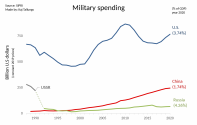DDG(X) is not even entering service until 2032. NGAD is only entering service in 2030s.Disagree. There will be a window of opportunity between 2027-2030 where American and Japanese warships and aircraft are retired faster than their replacements as described here: . After that, introduction of next generation western platforms like NGAD and the LRASM successor will make the current A2/AD strategy much less tenable.
Public war games (which tend to massively favor United States) project that if war were to break out today, LRASM inventory would be burned through within days.
There is no magic bullet that wins wars. Capability doesn't just need to exist, it needs to exist in meaningful quantities in order to generate substantive effects. A Pacific War in 2030s is going to be fought with Flight 3 Burkes, Nimitz carriers, F-35s, and at best, NSMs and JATMs. Both of which are responses to Chines MIC developments, not new capabilities.
Meanwhile, what is coming online from China by the end of 2030s?
Type 95 submarines.
Next generation SSBNs.
1-2 new carriers.
J-20B
J-35
J-15B
H-20
PL-XX missiles.
Now forget new platforms and everything I forgot to mention, what is China going to have in quantity?
1-3 batches of 054B frigates.
At least 1 new batch of Type 055 Destroyers
J-16D EW Fighters
J-20s
DF-26 and DF-21Ds
Several more SSNs
KJ-500s (already dozens of these)
Y-20s
Y-8 ASW variants
I could go on and on.
China's newest generation of destroyers have reached parity and even superseded US designs in size, radar capability, and armaments. They have developed new platforms faster, continuously improved and retrofitted older inventory, have arguably outbuilt us in every conceivable platform, and have essentially reached technological parity it not leapfrogged us in several systems like IRBMs and AAMs. And they have done this with less GDP.
Now you really want to bet that we could outdevelop and outbuild this country when they have the same or greater GDP?
You really wanna see how far behind we will be after 2030s?
Please, the window for United States to choke out and destroy China is rapidly coming to a close. We either do it now or never.
Personally, I vote to live and let live, admit that we cannot defend Taiwan and move on with our lives. If we want to retain hegemony, we basically have to get our own shit in order, and pray that China somehow massively fucks up and destroys its own potential.
That statistic is meaningless. Whether the PLA has the production capacity and standing force to shatter the Anglo-Japanese forces within the second island chain and keep the SLOCs open is the relevant question. The answer to that currently is no.
The PLA should've received massively engorged budgets by year two of the Trump trade war. Instead the PRC leadership and population coped, gaslit themselves with empty slogans, and slept walk into these heightened tensions with an insufficient expeditionary fighting capability and lagging strategic nuclear force.
The answer to these questions is not no. The answer to this question is a big fat question mark.
As for PLA "massively engorging their budget". All I'm gonna do is post this graph.

Chinese spending is not only sustainable, it's almost downright reasonable. In fact, if this was United States, they'd be crying about how the military budget is far too small. The idea that China is pumping unearned billions into its budget is farcical. China's military budget is growing because their economy is growing. China is outbuilding and outspending us in military procurement because they are far better at building things than we are. Therefore, their unit costs end up much lower than ours, despite having similar capability and technological sophistication.
We lost this race in 2010s. By the time Obama pivoted to Asia, it was too late. We did not fix our industrial base. We had 10 years to do so since then and we've done jack shit. You wanna blame someone, blame the people who thought we could keep getting away with gaslighting the world about international law with zero consequences. Eventually, "business as usual" ends.

